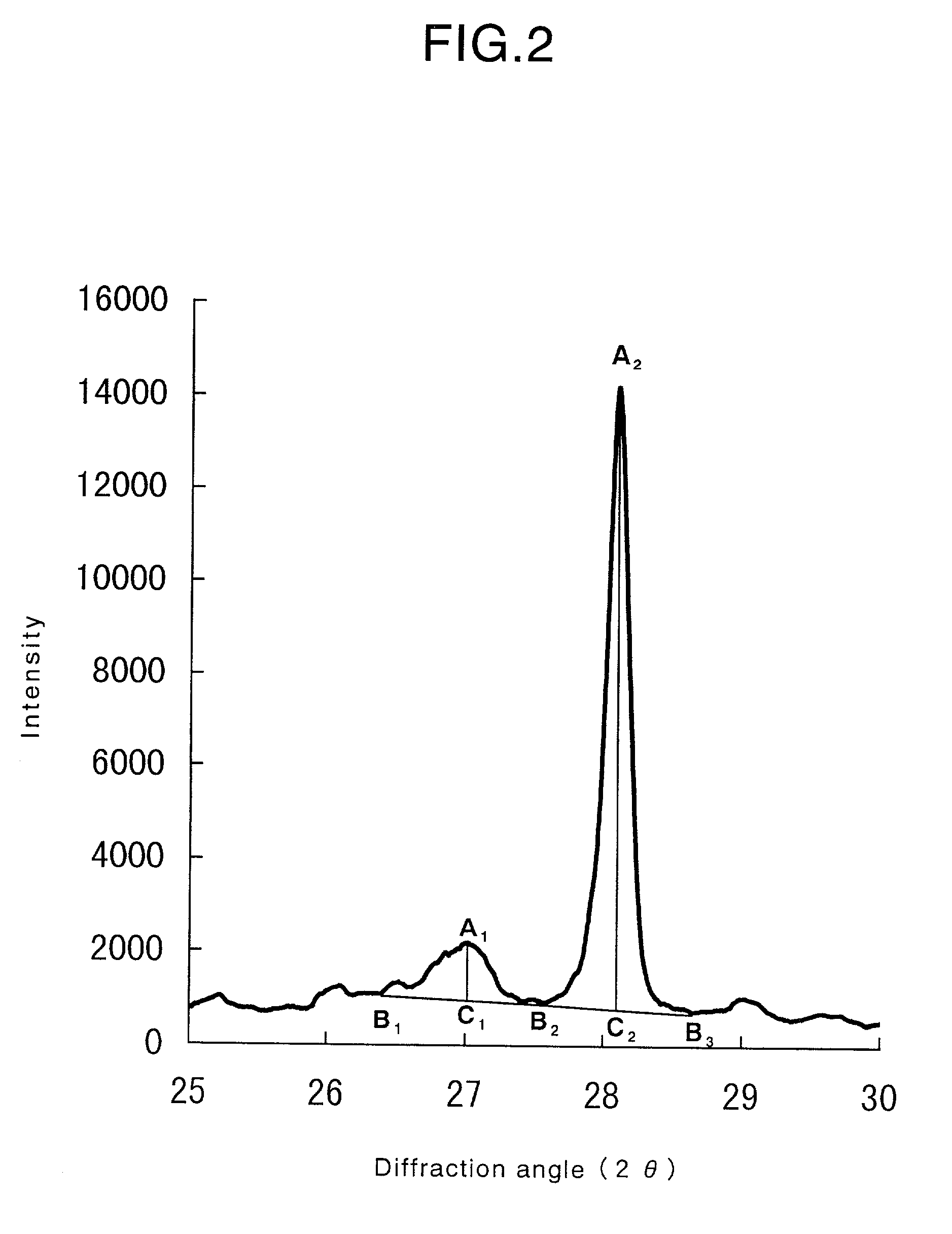Oxide catalyst for oxidation or ammoxidation
a catalyst and ammoxidation technology, applied in the field of oxide catalysts, can solve the problems of insufficient selectivity of the desired product, disadvantageous low stability of oxide catalysts capable of achieving relatively high selectivity for the desired product, and the process for the catalytic ammoxidation or oxidation in the gaseous phase inevitably becomes cumbersome, etc., to achieve the effect of high selectivity and advantageous us
- Summary
- Abstract
- Description
- Claims
- Application Information
AI Technical Summary
Benefits of technology
Problems solved by technology
Method used
Image
Examples
example 1
(Preparation of a Catalyst)
[0218]An oxide catalyst represented by the formula: Mo1V0.23Sb0.26Nb0.09On / SiO2(45% by weight) was prepared as follows.
[0219]To 1,000 g of water were added 250 g of ammonium heptamolybdate [(NH4)6Mo7O24.4H2O], 38.1 g of ammonium metavanadate (NH4VO3) and 53.6 g of antimony(III) oxide (Sb2O3), and the resultant mixture was subjected to a reaction under reflux in an oil bath in the air at 100° C. for 2 hours, followed by cooling to 50° C. Subsequently, to the resultant reaction mixture was added 829 g of a silica sol having an SiO2 content of 30% by weight, followed by stirring for 30 minute. Then, to the resultant mixture was further added 250 g of 5 wt % aqueous hydrogen peroxide, and the resultant mixture was stirred at 50° C. for 1 hour to effect an oxidation treatment, to thereby obtain an aqueous mixture (A). By the oxidation treatment, the color of the mixture changed from dark blue to brown.
[0220]On the other hand, to 150 g of water were added 22.3 g...
example 2
(Preparation of a Catalyst)
[0229]An oxide catalyst represented by the formula: Mo1V0.23Sb0.25Nb0.09On / SiO2(45% by weight) was prepared as follows.
[0230]Preparation of an oxide catalyst was performed in substantially the same manner as in Example 1, except that the amount of antimony(III) oxide (Sb2O3) was changed from 53.6 g to 51.6 g, the amount of 5 wt % aqueous hydrogen peroxide was changed from 250 g to 241 g and the amount of silica sol was changed from 829 g to 823 g.
[0231]The composition of the oxide catalyst and the important conditions in the catalyst production process are shown in Table 1.
[0232]The obtained oxide catalyst exhibited, in an XRD pattern thereof, peaks at diffraction angles (2θ) of 7.8±0.3°, 8.9±0.3°, 22.1±0.3°, 27.1±0.3°, 28.1±0.3°, 35.2±0.3°, 36.1±0.3° and 45.2±0.3°, wherein R=0.09.
(Ammoxidation of Propane)
[0233]Using the obtained oxide catalyst, the ammoxidation reaction of propane was performed in the same manner as in Example 1. The results are shown in ...
example 3
(Preparation of a Catalyst)
[0234]An oxide catalyst represented by the formula: Mo1V0.24Sb0.25Nb0.09On / SiO2 (45% by weight) was prepared as follows.
[0235]Preparation of an oxide catalyst was performed in substantially the same manner as in Example 1, except that the amount of ammonium metavanadate (NH4VO3) was changed from 38.1 g to 39.7 g, the amount of antimony(III) oxide (Sb2O3) was changed from 53.6 g to 51.6 g, the amount of 5 wt % aqueous hydrogen peroxide was changed from 250 g to 241 g and the amount of silica sol was changed from 829 g to 827 g.
[0236]The composition of the oxide catalyst and the important conditions in the catalyst production process are shown in Table 1.
[0237]The obtained oxide catalyst exhibited, in an XRD pattern thereof, peaks at diffraction angles (2θ) of 7.8±0.3°, 8.9±0.3°, 22.1±0.3°, 27.1±0.3°, 28.1±0.3°, 35.2±0.3°, 36.1±0.3° and 45.2±0.3°, wherein R=0.09.
(Ammoxidation of Propane)
[0238]Using the obtained oxide catalyst, the ammoxidation reaction of pr...
PUM
| Property | Measurement | Unit |
|---|---|---|
| Temperature | aaaaa | aaaaa |
| Angle | aaaaa | aaaaa |
| Angle | aaaaa | aaaaa |
Abstract
Description
Claims
Application Information
 Login to View More
Login to View More - R&D
- Intellectual Property
- Life Sciences
- Materials
- Tech Scout
- Unparalleled Data Quality
- Higher Quality Content
- 60% Fewer Hallucinations
Browse by: Latest US Patents, China's latest patents, Technical Efficacy Thesaurus, Application Domain, Technology Topic, Popular Technical Reports.
© 2025 PatSnap. All rights reserved.Legal|Privacy policy|Modern Slavery Act Transparency Statement|Sitemap|About US| Contact US: help@patsnap.com



